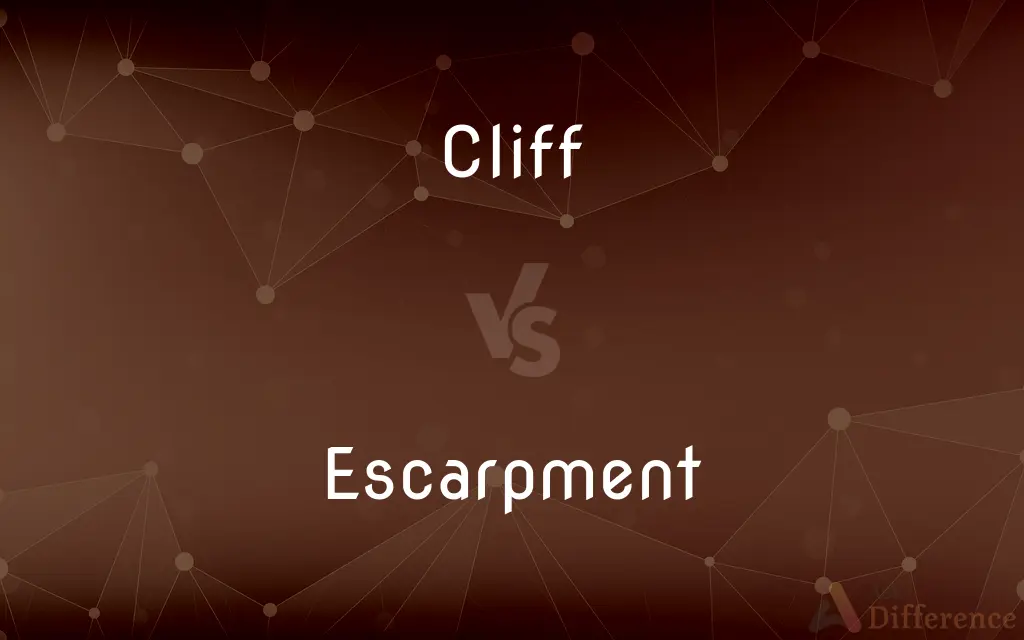Cliff vs. Escarpment — What's the Difference?
By Maham Liaqat & Urooj Arif — Updated on March 7, 2024
A cliff is a steep, vertical, or near-vertical rock face, often found along coastlines or in mountainous regions, while an escarpment is a long, steep slope that separates two flat or gently sloping areas, resulting from erosion or faulting.

Difference Between Cliff and Escarpment
Table of Contents
ADVERTISEMENT
Key Differences
A cliff is characterized by its steepness and vertical or near-vertical rock faces, making it a dramatic landscape feature. Cliffs are often associated with the erosive forces of water, such as those found along coastlines or riverbanks, where the action of waves or current undercuts the base of the rock. On the other hand, an escarpment is a more extensive geological feature that forms a significant boundary between two differing levels of terrain, usually as a result of tectonic activities like faulting or erosion over geological timescales.
Cliffs can occur in various environments, including mountainous areas, deserts, and along coastlines, showcasing a diverse range of geological compositions from sedimentary to igneous rocks. Escarpments, while they can be composed of different rock types, are often notable for their role in defining regional landscapes, creating natural barriers, and influencing climate and biodiversity by their sheer size and extent.
The formation of cliffs is typically due to processes such as erosion and weathering, where water, ice, and wind play significant roles in carving out these steep faces. Escarpments, however, may form through a combination of erosional processes and tectonic movements, where the earth's crust has been pushed upward or has slipped, creating a long, steep slope that marks the transition between two levels of terrain.
While cliffs offer spectacular views and are popular among tourists and climbers for their beauty and challenge, escarpments have broader implications for the environment and human activities. They can affect weather patterns, serve as barriers to movement, and have historically provided strategic defense locations. Escarpments may also influence local climates, creating rain shadows or serving as catchment areas for rivers and streams.
Both cliffs and escarpments contribute significantly to Earth's geomorphology, offering insights into the planet's geological history and processes. Their study helps scientists understand past environmental conditions, the movement of tectonic plates, and the effects of erosion and deposition over millions of years.
ADVERTISEMENT
Comparison Chart
Definition
A steep, vertical rock face.
A long, steep slope separating terrains.
Formation
Erosion and weathering by water, ice, wind.
Erosion and tectonic movements.
Location
Coastlines, mountainous areas, deserts.
Between two flat or gently sloping areas.
Geological Role
Erosive forces shape cliffs.
Marks tectonic activity or erosion.
Environmental Impact
Offers habitats, affects local microclimates.
Influences climate, biodiversity, human activity.
Examples
White Cliffs of Dover, El Capitan.
Great Escarpment, Brazil; Niagara Escarpment, Canada.
Compare with Definitions
Cliff
A high, steep face of rock or earth.
The White Cliffs of Dover are famous for their stunning views over the English Channel.
Escarpment
Often results from faulting or erosion.
The Niagara Escarpment is a result of differential erosion of rock layers over millennia.
Cliff
Provides unique ecosystems for various species.
Sea bird colonies thrive on the inaccessible ledges of ocean cliffs.
Escarpment
Marks significant geological events and processes.
The scarp face often exposes layers of Earth's history, revealing ancient environments and changes.
Cliff
Varies in composition, including sandstone and limestone.
The red sandstone cliffs add dramatic color to the desert landscape.
Escarpment
Influences regional climate and hydrology.
Escarpments can create rain shadows, affecting local weather patterns.
Cliff
Formed primarily by the action of water and weather.
Coastal cliffs are often created by the relentless pounding of waves.
Escarpment
Serves as a barrier and a biodiverse habitat.
Many unique plant and animal species are found along the slopes of escarpments.
Cliff
A landmark for navigators and adventurers.
Climbers challenge themselves on the sheer cliffs of Yosemite.
Escarpment
An escarpment is a steep slope or long cliff that forms as a result of faulting or erosion and separates two relatively level areas having different elevations. The terms scarp and scarp face are often used interchangeably with escarpment.
Cliff
In geography and geology, a cliff is an area of rock which has a general angle defined by the vertical, or nearly vertical. Cliffs are formed by the processes of weathering and erosion, with the effect of gravity.
Escarpment
A long, steep slope, especially one at the edge of a plateau or separating areas of land at different heights.
Cliff
A steep rock face, especially at the edge of the sea
A coast path along the top of rugged cliffs
Escarpment
A steep slope or long cliff that results from erosion or faulting and separates two relatively level areas of differing elevations.
Cliff
A high, steep, or overhanging face of rock.
Escarpment
A steep slope in front of a fortification.
Cliff
A vertical (or nearly vertical) rock face.
Escarpment
A steep descent or declivity; steep face or edge of a ridge; ground about a fortified place, cut away nearly vertically to prevent hostile approach.
Cliff
(figurative) A point where something abruptly fails or decreases in value etc.
Escarpment
A steep descent or declivity; steep face or edge of a ridge; ground about a fortified place, cut away nearly vertically to prevent hostile approach. See Scarp.
Cliff
A high, steep rock; a precipice.
Escarpment
A long steep slope or cliff at the edge of a plateau or ridge; usually formed by erosion
Cliff
See Clef.
Escarpment
A steep artificial slope in front of a fortification
Cliff
A steep high face of rock;
He stood on a high cliff overlooking the town
A steep drop
Common Curiosities
How does an escarpment form?
Escarpments form through a combination of tectonic activity and erosion, creating long, steep slopes.
What is the significance of cliffs and escarpments in nature?
They play crucial roles in biodiversity, weather patterns, and geomorphology, providing habitats and affecting climates.
Can cliffs be found on escarpments?
Yes, cliffs can be part of escarpments, marking the steep edges of these extensive geological features.
How do cliffs and escarpments differ in their impact on human activities?
While cliffs may pose challenges for navigation and offer recreational opportunities, escarpments can influence settlement patterns, agriculture, and strategic defense due to their size and location.
What role do water and wind play in the formation of cliffs?
Water and wind are primary agents in cliff formation, through processes like erosion and weathering.
How do cliffs and escarpments affect local communities?
They can provide natural resources, recreational spaces, and influence local economies, but also pose natural barriers to development and transportation.
Why are cliffs and escarpments important for biodiversity?
Their unique environments support diverse ecosystems, often harboring species not found elsewhere.
What defines a cliff?
A cliff is defined by its steep, often vertical face, resulting primarily from erosional processes.
Are escarpments unique to certain regions?
No, escarpments can be found worldwide, marking geological transitions in landscapes across continents.
Can the study of escarpments reveal Earth's history?
Yes, escarpments often expose geological layers that tell stories of Earth's past environments and tectonic movements.
Share Your Discovery

Previous Comparison
Heat vs. Warm
Next Comparison
Extended vs. ExtensiveAuthor Spotlight
Written by
Maham LiaqatCo-written by
Urooj ArifUrooj is a skilled content writer at Ask Difference, known for her exceptional ability to simplify complex topics into engaging and informative content. With a passion for research and a flair for clear, concise writing, she consistently delivers articles that resonate with our diverse audience.
















































